MARIANI’S
May
2,
2010
NEWSLETTER
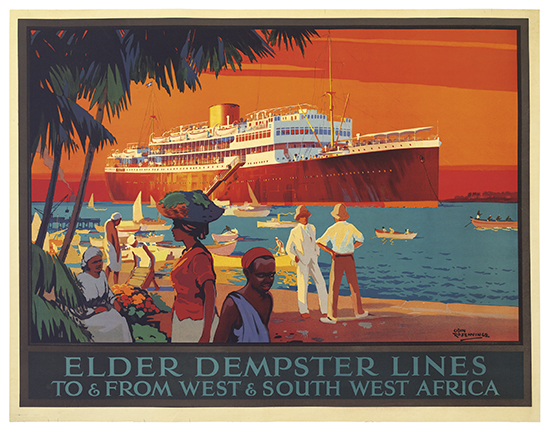
"Elder Dempster Lines"
(1925) by Odin Rosenvinge
`````````````````````````````````````````
➔ QUESTIONS? TO REACH JOHN MARIANI
WRITE
TO: newsletter@johnmariani.com.
➔ ARCHIVE: Readers
may now access
an
Archive of all past newsletters--each annotated--dating back to July,
2003, by simply clicking on www.johnmariani.com/archive
➔ SUBSCRIBE AND
UN-SUBSCRIBE: You may subscribe anyone you wish
to this newsletter--free of charge--by
clicking here.
THIS WEEK: HANDICAPPING THIS YEAR'S JAMES BEARD AWARDS.
~~~~~~~~~~~~~
☛ In
This Issue
DINING OUT IN
SALZBURG by John Mariani
NEW YORK CORNER:
David Burke Townhouse by John Mariani
10
HISTORIC
AMERICAN
RESTAURANTS by
John Mariani
QUICK BYTES
~~~~~~~~~~~~~
Dining
Out
in
Salzburg
by John Mariani
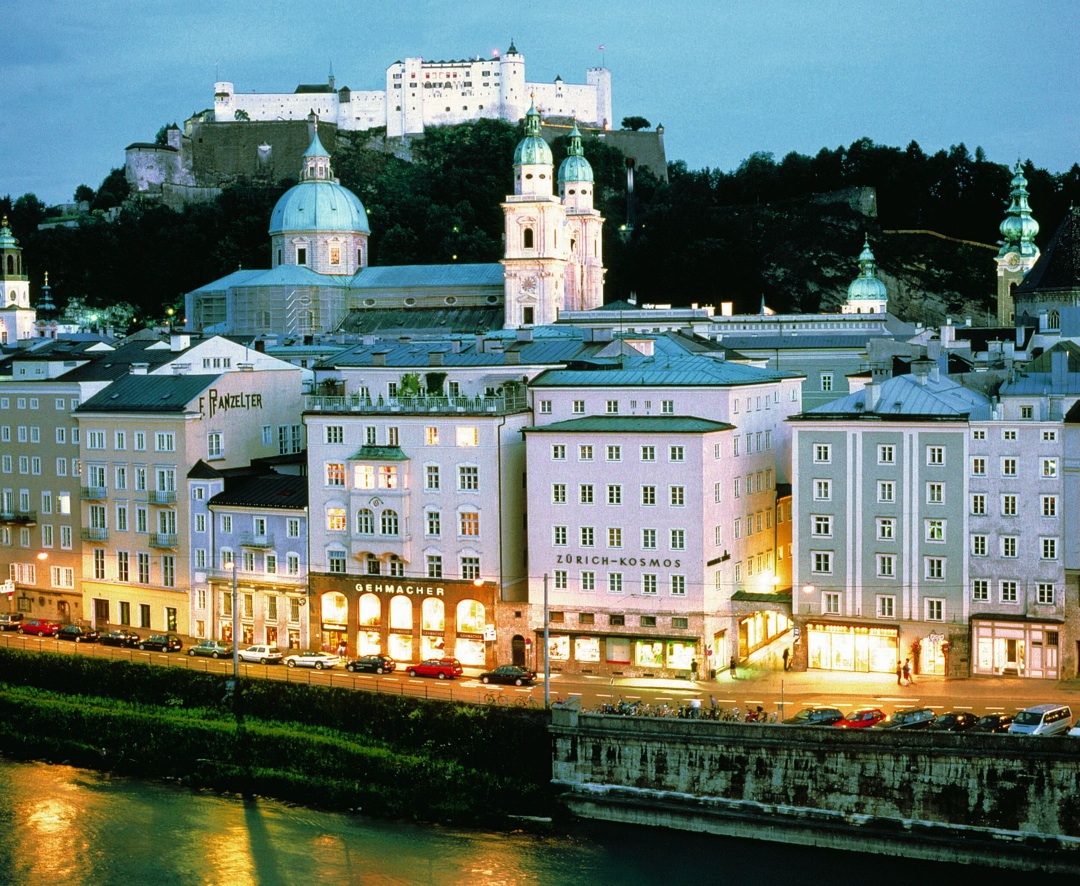
A fter the monumentality of Vienna, Salzburg welcomes the traveler, wherever he or she may come from, as a kind of old neighborhood town whose smallness and ease of getting around makes it seem familiar even on one's first visit. I myself had not been back in several years, but it will always be a place I could nestle in and been treated like an old friend.

The streets and the arcades had an embracing effect, the river flowed as calmly as ever, and the windows full of chocolate confections and ornately painted holiday eggs (right) made mid-January look as gaily decorated as Christmas or Easter time. The clothing shops were full of beautifully made loden coats, even dirndls, the old restaurants had changed not at all, and the old Wurst stand by the river is still open very late.
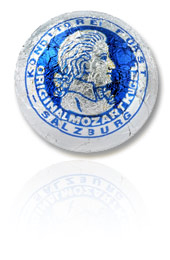 Salzburg is
chocolate mad, with confectioneries everywhere, their counters
beautifully lighted and full of candies of every color, arrayed and
stacked in rows
on silver trays. Two particular specialties created in the city are the
Salzburger
Mozartkugel (left) and
the Cappezzoli di Venere (below, right),
which means Venus's nipples. The former,
wholly expected in a city consumed with Mozart (it's said there is a
Mozart concert or recital going on in the city every day of the year
and you can visit the house he lived in), was created in 1890 by Paul
Fürst, which took a gold medal in the Paris Exhibition
of 1905. It is made of dark chocolate and wrapped in special paper, and
you can buy it at the four Fürst
confectioners in town.
Salzburg is
chocolate mad, with confectioneries everywhere, their counters
beautifully lighted and full of candies of every color, arrayed and
stacked in rows
on silver trays. Two particular specialties created in the city are the
Salzburger
Mozartkugel (left) and
the Cappezzoli di Venere (below, right),
which means Venus's nipples. The former,
wholly expected in a city consumed with Mozart (it's said there is a
Mozart concert or recital going on in the city every day of the year
and you can visit the house he lived in), was created in 1890 by Paul
Fürst, which took a gold medal in the Paris Exhibition
of 1905. It is made of dark chocolate and wrapped in special paper, and
you can buy it at the four Fürst
confectioners in town.Venus's Nipples are made from chestnut and nougat paste in white or dark chocolate, said to have been a favorite of composer and Mozart competitor Antonio Salieri, the fellow who erroneously but infamously was linked t
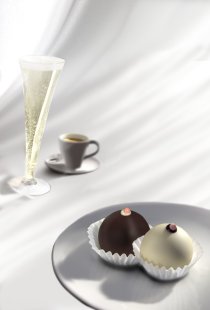 o
Mozart's demise in
the play "Amadeus." In any case, they are delicious candies and
are to be found int heir little paper cups at Scio's Speceyern, here since 1994.
o
Mozart's demise in
the play "Amadeus." In any case, they are delicious candies and
are to be found int heir little paper cups at Scio's Speceyern, here since 1994.Of course, the city also has its Sachertorte, the rich chocolate-and-apricot created in 1932 for Prince Metternich's court guests and forever associated with the Sacher Hotel in Vienna. There is a branch of the hotel in Salzburg equally as lovely, a bit more intimate, with an enclosed glass ceiling, a splendid, pale green Mozart Suite overlooking the river, and a beautifully decorated restaurant, the Salzhauben (below), which includes an impressive array of antlers and a stunning carved ceiling ans walls.
Its menu has just the right number of classic and modern dishes on it, nothing too extravagant, and you may go as simply as pike perch or a filet mignon with potatoes or have a fine fillet of sole with risotto
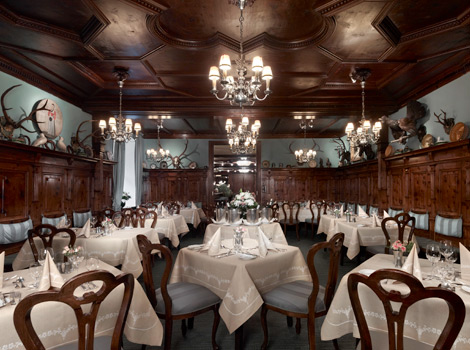 and a rich lobster sauce. Marinated
fillet of red tuna comes on sesame brittle with asparagus and a mango
chutney, while a heartier dish is the marinated shoulder of local beef
on a truffle rémoulade accompanied by beluga lentils laced with
balsamic vinegar. Of course you should have the Sachertorte for
dessert. Appetizers run €9.70 to €16.70, main courses €25.10 to
€29.10.
and a rich lobster sauce. Marinated
fillet of red tuna comes on sesame brittle with asparagus and a mango
chutney, while a heartier dish is the marinated shoulder of local beef
on a truffle rémoulade accompanied by beluga lentils laced with
balsamic vinegar. Of course you should have the Sachertorte for
dessert. Appetizers run €9.70 to €16.70, main courses €25.10 to
€29.10.Salzburg is a walking city, no, a strolling city, on both sides of the river Salzach. On the Sacher hotel's side, the narrow streets are far less tourist-polished than on the other side of the bridge. On one particular street you can see where World War II American tanks nicked chunks out of the buildings while trying to pass through.
There is a fine outdoor market on this side and one of the loveliest gourmet stores I've run across in Austria, the family-run Koelbl-Feinkost, stacked with local delicacies and wines, including an array of the best the country has to offer. Were you to hike off into the mountains, the provisions here would put you n good stead, from fine sausages and breads to local cheeses and wine. Also on this side of the river is the institution known as the Café Bazar (below, right) whose sturdy chairs and little tables have seated and served just about every important personage ever to grow up, live or visit Salzburg, from Marlene Dietrich to Max Reinhardt and Hugo von Hoffmannsthal. Begin your morning here with excellent coffee and pastries, meet friends for lunch, or drop by for more coffee and pastries in the afternoon. The Café Bazar seems perpetually full of locals, well-dressed
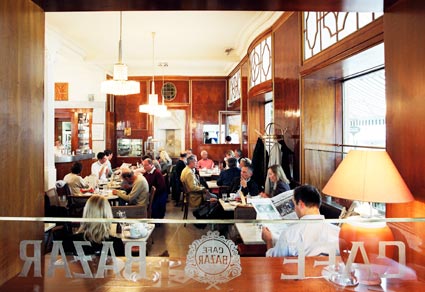 matrons, young women with their school friends, and
businessmen with their Blackberrys.
matrons, young women with their school friends, and
businessmen with their Blackberrys.Wander the little streets here and you'll find a slew of new bistros and trattorias, some with just a few tables, like Bruno Nuovo on Priesterhausgasse, a modern restaurant in deep gray, white, and red tones, where mustachioed Bruno Plotegher turns out pastas with truffles and modern cucina italiana.
Across the bridge in the main part of the city, with one of the best restaurants (with hotel) and an excellent winelist, Blau Gans (Blue Goose), whose arched ceilings, casual but tasteful arrangement of chairs and tables, and a young, enthusiastic service staff led by owner Andrea Gfrerer, turns out contemporary Austrian fare. The premises supposedly are the city's oldest guesthouse, dating back 650 years. In the bar you can drink and eat lightly from items like marinated salmon trout with a pumpkin chutney; smoked goose breast with pepperonata; fried chicken with cucumber salad; and of course, Weiner Schnitzel.
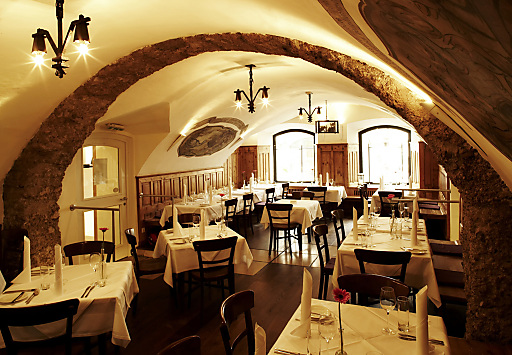 In
the
very
cozy
(non-smoking)
main dining
room (left), Chef Heidi
Neuländtner's menu is more extensive but not very
expensive at all, with the highest priced main course is €19.90, the
lowest priced €14.90. There are also multi-course fixed price
menus between €31 and €41.
In
the
very
cozy
(non-smoking)
main dining
room (left), Chef Heidi
Neuländtner's menu is more extensive but not very
expensive at all, with the highest priced main course is €19.90, the
lowest priced €14.90. There are also multi-course fixed price
menus between €31 and €41.We were delighted with an array of dishes that showed the breadth of cooking here, from beef cheeks with risotto and fines herbes to housemade liverwurst; a tender, flavorful char was simply roasted with a parsnip sauce. There was also ravioli stuffed with pike, and a dish of boneless butter-fried chicken. Chicken also comes sautéed and scented with lime juice, and brook trout is sautéed and served with a fennel sauce.
T here are five desserts, including the impossible-to-pronounce Powidltascherl,
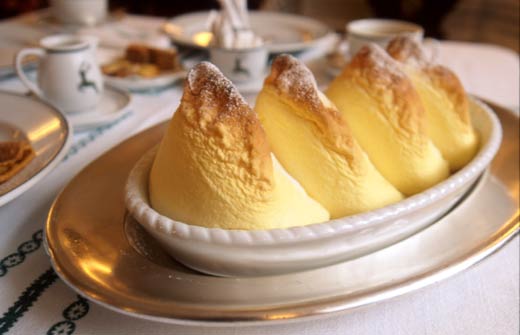 which are little prune-filled dumplings with a vanilla
sauce, and
the city's famous Salzburger Nockerl
(right),
a kind of Austrian version of French île
flottante
and America's baked Alaska--a
big froth of vanilla-scented browned meringue on a plate with raspberry
sauce,
really a guilty pleasure that you will find yourself polishing off with
your friends (it's baked for two people). The story goes that the dish
was created in the 17th century for Salome Alt, an excellent name for
the
mistress of the archbishop of Salzburg, and classically shaped to
look like the three peaked hills that surround Salzburg.
Historically speaking, this is suspect, for the idea of
browning egg whites has been traced specifically to an American
experimenter named Benjamin Thompson in the late 18th or early 19th
century. But whenever Salzburger Nockerl came along, it
was and continues to be a delightful dessert.
which are little prune-filled dumplings with a vanilla
sauce, and
the city's famous Salzburger Nockerl
(right),
a kind of Austrian version of French île
flottante
and America's baked Alaska--a
big froth of vanilla-scented browned meringue on a plate with raspberry
sauce,
really a guilty pleasure that you will find yourself polishing off with
your friends (it's baked for two people). The story goes that the dish
was created in the 17th century for Salome Alt, an excellent name for
the
mistress of the archbishop of Salzburg, and classically shaped to
look like the three peaked hills that surround Salzburg.
Historically speaking, this is suspect, for the idea of
browning egg whites has been traced specifically to an American
experimenter named Benjamin Thompson in the late 18th or early 19th
century. But whenever Salzburger Nockerl came along, it
was and continues to be a delightful dessert.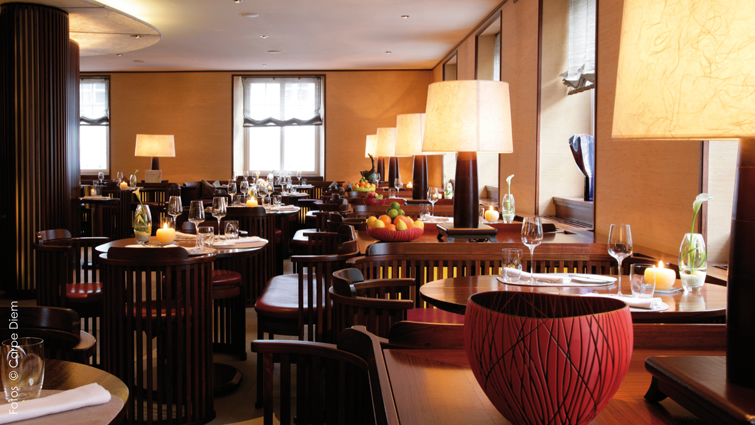 Just a cross the street from the ancient Blau
Gans is a
very, very up-to-the-moment, swank bar and restaurant called Carpe Diem Finest Fingerfood, mixing two
non-Germanic languages into one name. Downstairs is a loud, terribly
smoke-filled bar where the beer and cocktails flow; up a beautiful
winding staircase is the restaurant (left)
where,
indeed,
the
menu
is composed of foods best (below)
eaten
by
picking them up in
your fingers. A lounge is also in place where you can literally sink
into leather sofas and armchairs that look like poured red taffy.
Then there is the Champagne Bar and the open terrace in good weather,
overlooking
Just a cross the street from the ancient Blau
Gans is a
very, very up-to-the-moment, swank bar and restaurant called Carpe Diem Finest Fingerfood, mixing two
non-Germanic languages into one name. Downstairs is a loud, terribly
smoke-filled bar where the beer and cocktails flow; up a beautiful
winding staircase is the restaurant (left)
where,
indeed,
the
menu
is composed of foods best (below)
eaten
by
picking them up in
your fingers. A lounge is also in place where you can literally sink
into leather sofas and armchairs that look like poured red taffy.
Then there is the Champagne Bar and the open terrace in good weather,
overlooking 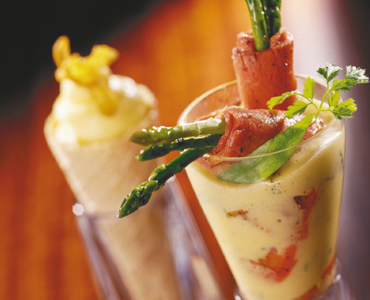 the main thoroughfare, Getreidegasse. So you see
people here for lunch, tea, pre-opera or theater, and
aprés-opera and
theater, along with those who just come to meet someone they know or
someone they'd like to meet.
the main thoroughfare, Getreidegasse. So you see
people here for lunch, tea, pre-opera or theater, and
aprés-opera and
theater, along with those who just come to meet someone they know or
someone they'd like to meet.The finger foods really are terrific and very beautifully composed, not least their cones, which contain everything from chicken wings to beef tartare, even paprika couscous, a small hamburger and a dry version of Tafelspitz. There are also a number of sandwiches, two or three of them making a meal, like pumpernickel stuffed with smoked salmon, caviar, and sour cream. Desserts follow the same patterns, with cones of chocolate, even Salzburger Nockerl, and the Carpe Diem Gugelhupf in various flavors of chocolate, hazelnut, and marzipan.
F or something far more traditional, there is Triangle, a very low -priced hangout for locals, especially students, because the University owns the building and keeps menu prices in line so that a good meal can be had for very little. The blackboard postings each day indicate what's most fresh and good, the cheery room is chockablock with old wood tables, and the beer flows freely.
I visited but did not have a chance to eat at any of the numerous dining rooms at the marvelous Stiftskeller St. Peter's, a rambling structure that, like Blaue Gans above, claims to be Europe's oldest inn, based on a document dating back to the year 803 A.D. at St. Peter's Arch
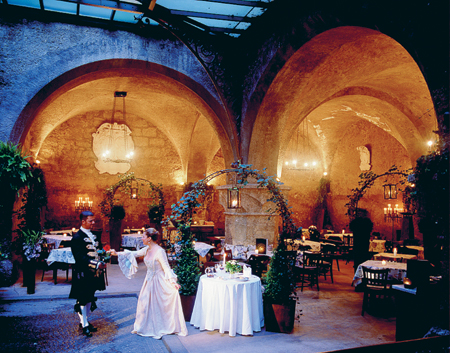 Abbey, where Charlemagne is said to have dropped by.
Legend also has it that Faust met the demonic Mephistopheles here. The
facility, which
does hundreds of banquets and weddings each year (the website of course
plays Mozart's music), has been run since 1992 by the Haslauer family
who have spared no expense to provide just about any antique
décor you
could wish, including the Haydn Room, the Baroque Hall, the Virgil
Salon, and Refugium. At Christmas the seminary garden and cave (left) take on all the trappings and
lights of an Austrian winter; they also offer a Mozart menu with
musical presentation.
Abbey, where Charlemagne is said to have dropped by.
Legend also has it that Faust met the demonic Mephistopheles here. The
facility, which
does hundreds of banquets and weddings each year (the website of course
plays Mozart's music), has been run since 1992 by the Haslauer family
who have spared no expense to provide just about any antique
décor you
could wish, including the Haydn Room, the Baroque Hall, the Virgil
Salon, and Refugium. At Christmas the seminary garden and cave (left) take on all the trappings and
lights of an Austrian winter; they also offer a Mozart menu with
musical presentation.I have said little about the maestro himself for you cannot walk a block in Salzburg without someone or something reminding you that Johannes Chrysostomus Wolfgangus Theophilus Mozart was born on Getreidegasse street--gold letters mark the spot--in 1756 and spent a good deal of his short life in the city, employed from 1773-1777 as a court musician by Prince-Archbishop Hieronymus Colloredo. Though often dissatisfied with Salzburg as too small and provincial for his ambitions and talents, Mozart traveled widely through Europe, and he died in Vienna, but Salzburgers know well that Mozart was theirs and the city nurtured him in its narrow streets and plazas, gardens, and riverwalks, a beautiful, quiet city whose churches and theaters sometimes rang with the sound of his genius.
Austria is a country of many cultural surprises, so I found it odd that the Austrians, particularly the people of Salzburg, shrug at the mention of "The Sound of Music." Despite the enormous tourist attention the movie and the Trapp Family
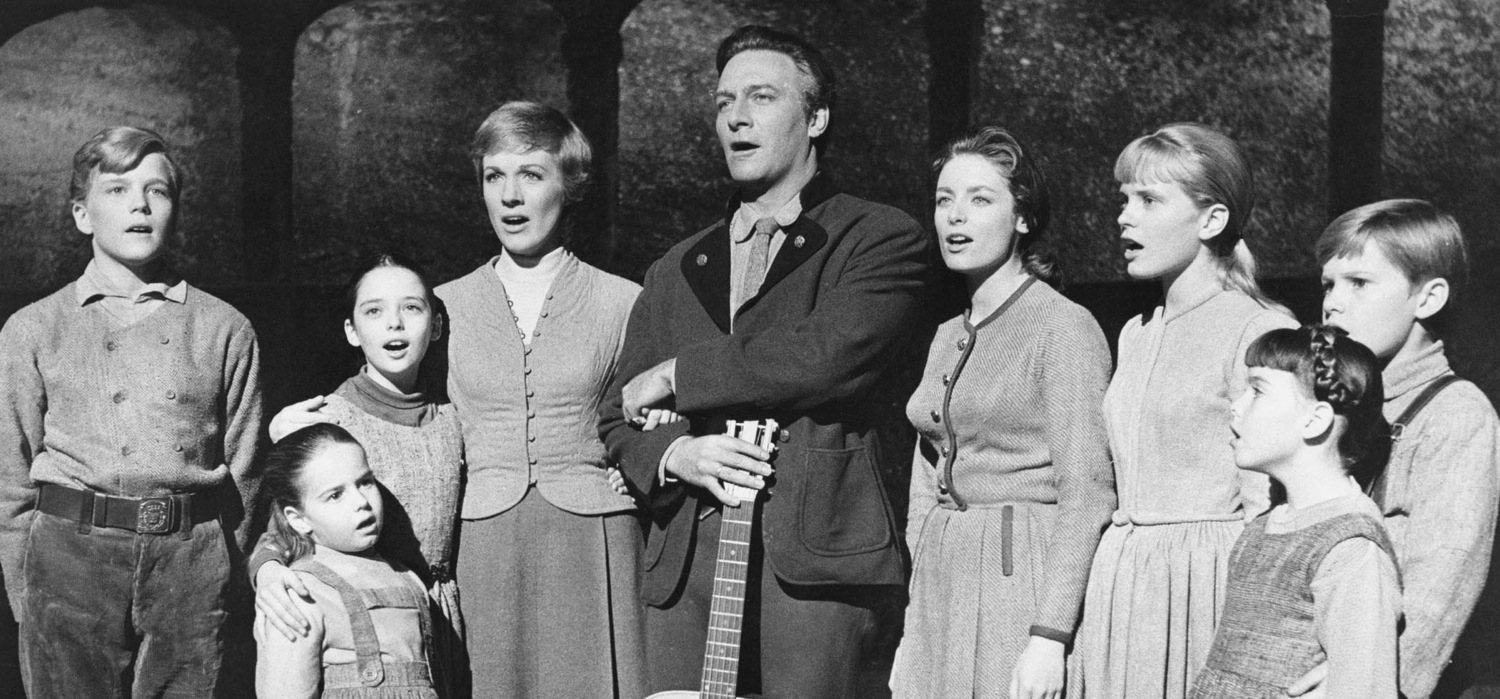 have
brought to
the city, there have been few efforts to promote them. "The
Sound of Music" has had, of course, phenomenal success
worldwide, with Julie Andrews singing her English heart out in
the
hills of
Austria, marrying stiff-necked Christopher Plummer (who hated the movie!) and
forming the Trapp Family
singers, escaping from the Nazis into Switzerland (although in
actuality, they slipped across the border by train to nearby
Italy). I must
say
that watching a DVD of "The Sound of Music" in the Mozart Suite at the
Sacher Hotel in Salzburg added further luster to the city and
the
story, even if the movie is complete dreck, with all those cloyingly
cute Hollywood children and singing nuns. You can easily,
however,
pick up a
brochure that tells the true story of the Trapp family (who
eventually moved to Vermont an opened a lodge-style hotel), and
includes a guide to the film's shooting locations around the region,
including Nonnberg Convent, Mondsee Church, Residenz Square, Mirabell
Gardens, and Leopoldskron Palace Park.
have
brought to
the city, there have been few efforts to promote them. "The
Sound of Music" has had, of course, phenomenal success
worldwide, with Julie Andrews singing her English heart out in
the
hills of
Austria, marrying stiff-necked Christopher Plummer (who hated the movie!) and
forming the Trapp Family
singers, escaping from the Nazis into Switzerland (although in
actuality, they slipped across the border by train to nearby
Italy). I must
say
that watching a DVD of "The Sound of Music" in the Mozart Suite at the
Sacher Hotel in Salzburg added further luster to the city and
the
story, even if the movie is complete dreck, with all those cloyingly
cute Hollywood children and singing nuns. You can easily,
however,
pick up a
brochure that tells the true story of the Trapp family (who
eventually moved to Vermont an opened a lodge-style hotel), and
includes a guide to the film's shooting locations around the region,
including Nonnberg Convent, Mondsee Church, Residenz Square, Mirabell
Gardens, and Leopoldskron Palace Park.`````````````````````````````````````````
NEW
YORK CORNER
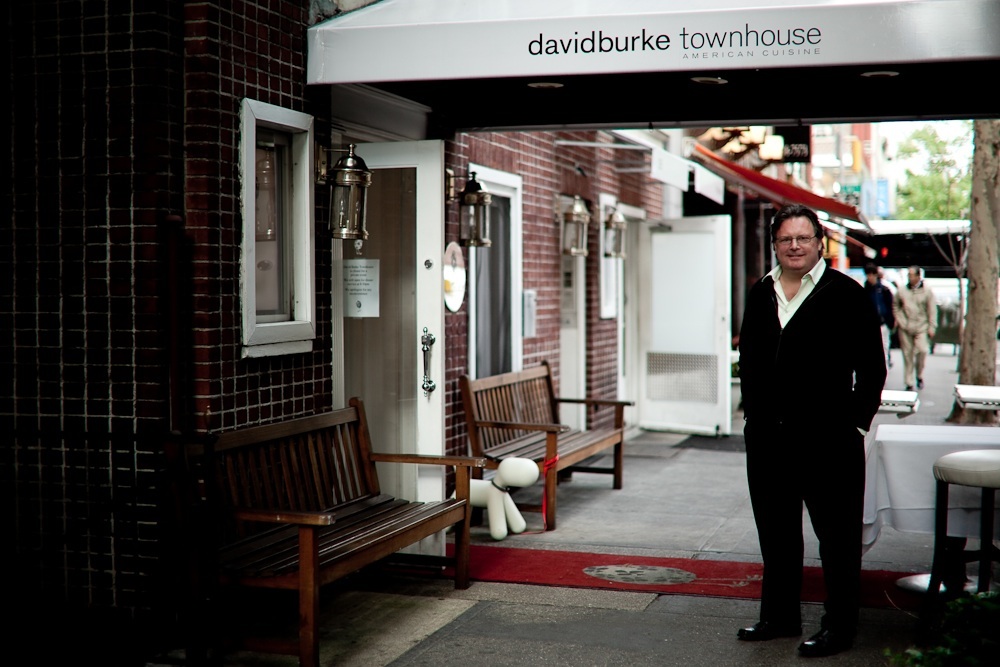
133 E. 61st Street (near Lexington Avenue)
212-813-2121
www.davidburketownhouse.com
david Burke has for some time now been among New York's most highly regarded chefs, first distinguishing himself at River Café, then at Park Avenue Café, owned by the Smith & Wollensky Restaurant Group for which he became VP of Culinary Development. In 2003, Burke teamed up with Donatella Arpaia to open davidburke & donatella, then went on to open David Burke at Bloomingdale’s, Burke in the Box and David Burke Prime at Foxwoods Resort & Casino, David Burke’s Primehouse in The James Chicago Hotel, Fromagerie in Rumson, NJ, David Burke Las Vegas, at Foxwoods Casino & Resort, and, last year, Fishtail by David Burke in NYC. Along the way, he has also gotten into food product lines and is a consultant to Hawaiian Tropic Zone in NYC and Las Vegas. Ooooh-kay.
If all that seems to be a lot on one man's plate, well, of course it is. And from rampant expansion comes plenty of room for error and a concomitant raising of the media's collective eyebrows about quality control. and real commitment. Still, after buying out his partner Donatella Arpaia (who herself now runs nine restaurants) at davidburke & donatella, Burke has clearly sought to reclaim eminence at this, his flagship on East 61st Street. A recent visit, with Burke and exec chef Sylvain Delpique in attendance, indicated to me that when he is on, Burke is still one of NYC's most distinctive chefs with a generous style all his own. Some of his signature dishes are in fact still on the menu--the pretzel-coated crabcake and the lobster "steak"--and there is always a flourish in his presentations, which are always more fun than they are pretentious.
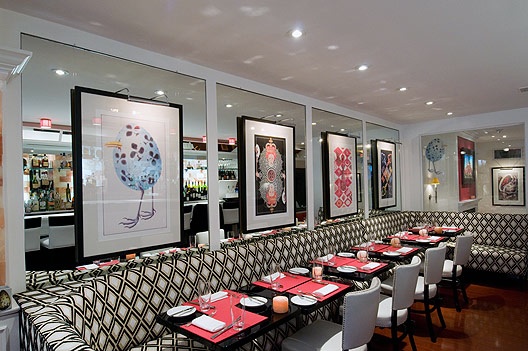 The space has always been oddly configured since this was
the old line Italian ristorante
Nanni Al Valletto, with three levels and no windows in the high
ceilinged dining room. The bar (left)
was
once
cramped
and uninviting, now a glistening, handsome and roomy
spot for a cocktail, with small tables set against banquettes. There is
a backlighted pink Himalayan salt wall (Burke was among the first to
use Himalayan salt blocks in his cooking, too). The two dining
rooms are festooned with Venetian glass balloons, and, for reasons that
escape me, there is a dungeon-like door and keys affixed to a rear
wall. There is also a wine display that holds a portion of the 5,000
bottles stored here by wine director Jared Shepard.
The space has always been oddly configured since this was
the old line Italian ristorante
Nanni Al Valletto, with three levels and no windows in the high
ceilinged dining room. The bar (left)
was
once
cramped
and uninviting, now a glistening, handsome and roomy
spot for a cocktail, with small tables set against banquettes. There is
a backlighted pink Himalayan salt wall (Burke was among the first to
use Himalayan salt blocks in his cooking, too). The two dining
rooms are festooned with Venetian glass balloons, and, for reasons that
escape me, there is a dungeon-like door and keys affixed to a rear
wall. There is also a wine display that holds a portion of the 5,000
bottles stored here by wine director Jared Shepard.The place gets a jolly crowd of regulars and plenty of upper east siders and shoppers from Bloomingdale's nearby, and Burke clearly wants everyone to have fun in a room lacking any stuffiness whatever. Service fits that theme well. There's a lot of playfulness on the well-balanced menu, too, starting with a Thai lobster consommé with lobster dumplings, snow peas and pineapple, served in a tall glass vial. The concoction is delicious. That signature pretzel-coated crabcake makes a lot of tasty, textural sense really, accompanied by tomato-orange chutney and poppyseed honey. The "crisp & angry lobster" lives up to its billing, with an assertive whack of basil and lemon-chili sauce.
Each of these appetizers show that while Burke can have some fun, the resolution on the plate is always about the true flavor of the ingredients, which are never deliberately manipulated in the molecular cuisine style.
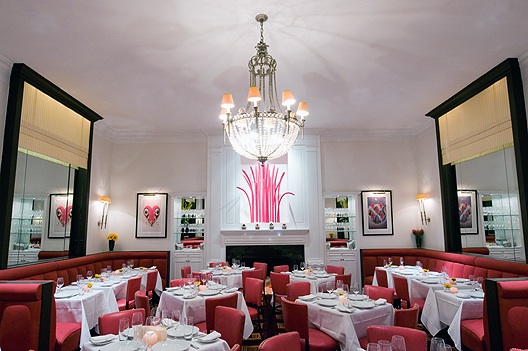 Thus, truffled ricotta egg ravioli and shrimp chorizo taste of exactly what they
are, with the surprise on the side of julienned apple and olive slaw
with a charred tomato vinaigrette.
Thus, truffled ricotta egg ravioli and shrimp chorizo taste of exactly what they
are, with the surprise on the side of julienned apple and olive slaw
with a charred tomato vinaigrette. Main dishes are just as whimsical, and portions have long been a hallmark of Burke's cooking. So you get a big "Bronx style filet mignon" of veal and veal cheek tied to orange-infused cauliflower puree and pistachio ravioli. Cavatelli nubbins are laced with long-braised, deeply flavorful shortribs with wild mushrooms, mushrooms chips, and a truffle mousse--a lavish pasta dish whose ingredients all make perfect, woodsy sense. For something simpler, there is always a whole roasted fish of the day--dorade that evening--with spaghetti and squash and charred tomato vinaigrette (curious, only because he used the same vinaigrette on the truffled ravioli). The one dish I had that left me scratching my head was a marriage of a rack of lamb with roasted octopus, a cocoa bean romesco, arugula, and saffron mustard. Little on that plate complemented anything else, and the octopus was, that night, quite fishy. By the way, even if you don't need them, order the side of whipped potatoes with roasted garlic and lemon--terrific.
 There's
still
Jennifer Domanski's desserts to go, and they seem not tame by
comparison but just about right--a wow of a simple butterscotch panna cotta with crunchy meringue
and curried gelée; a caramelized warm apple tart with cider,
caramel and dulce de leche ice
cream,
excellent
gelato with
cocoa nib foam and hazelnut-chocolate fudge; and then there's his
signature cheesecake lollipop tree, which, with its real bubblegum
whipped cream and raspberries, might confuse the palate even of a
sugar-addicted child. In any case, it's a $10 supplement to the
prix fixe menu, but it serves at least two, if you like that sort of
thing.
There's
still
Jennifer Domanski's desserts to go, and they seem not tame by
comparison but just about right--a wow of a simple butterscotch panna cotta with crunchy meringue
and curried gelée; a caramelized warm apple tart with cider,
caramel and dulce de leche ice
cream,
excellent
gelato with
cocoa nib foam and hazelnut-chocolate fudge; and then there's his
signature cheesecake lollipop tree, which, with its real bubblegum
whipped cream and raspberries, might confuse the palate even of a
sugar-addicted child. In any case, it's a $10 supplement to the
prix fixe menu, but it serves at least two, if you like that sort of
thing.So, you're not going to go to davidburke's townhouse for a simple repast. Nor should you go expecting the extreme forms of avant-garde cuisine that has already become so passé. You go here for David Burke's cuisine, which is wholly his and reflective of the big guy's generosity of spirit. Just hope he's there when you go.
David Burke Townhouse is open for brunch Sat. & Sun and dinner nightly. Starters run $14-$24, main courses $29-$44.
HISTORIC
AMERICAN RESTAURANTS
by
John Mariani
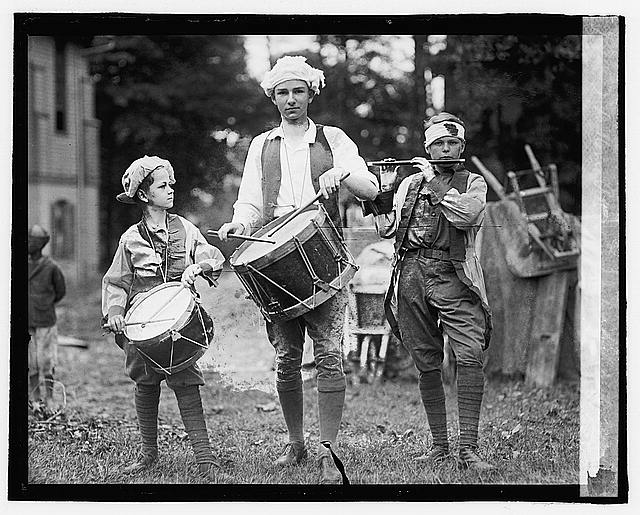
Fourth of July, Tacoma Park, 1922
With the spring and summer
holidays coming up, historic restaurants seem to fit the bill for Mom,
Dad, Memorial Day, and the 4th of July.
Although America has always
had its taverns and inns serving food ever since the Pilgrims landed
here, the
restaurant as we know it—a place where you can sit at your own table,
have your
own waiter, and order from a menu—is of rather recent origin. None is more famous than Boston’s Durgin-Park
Café, still serving much
the same kind of New England fare, although you’ll eat just as they did
when it
opened in 1827, at common tables with visitors from all over the world.
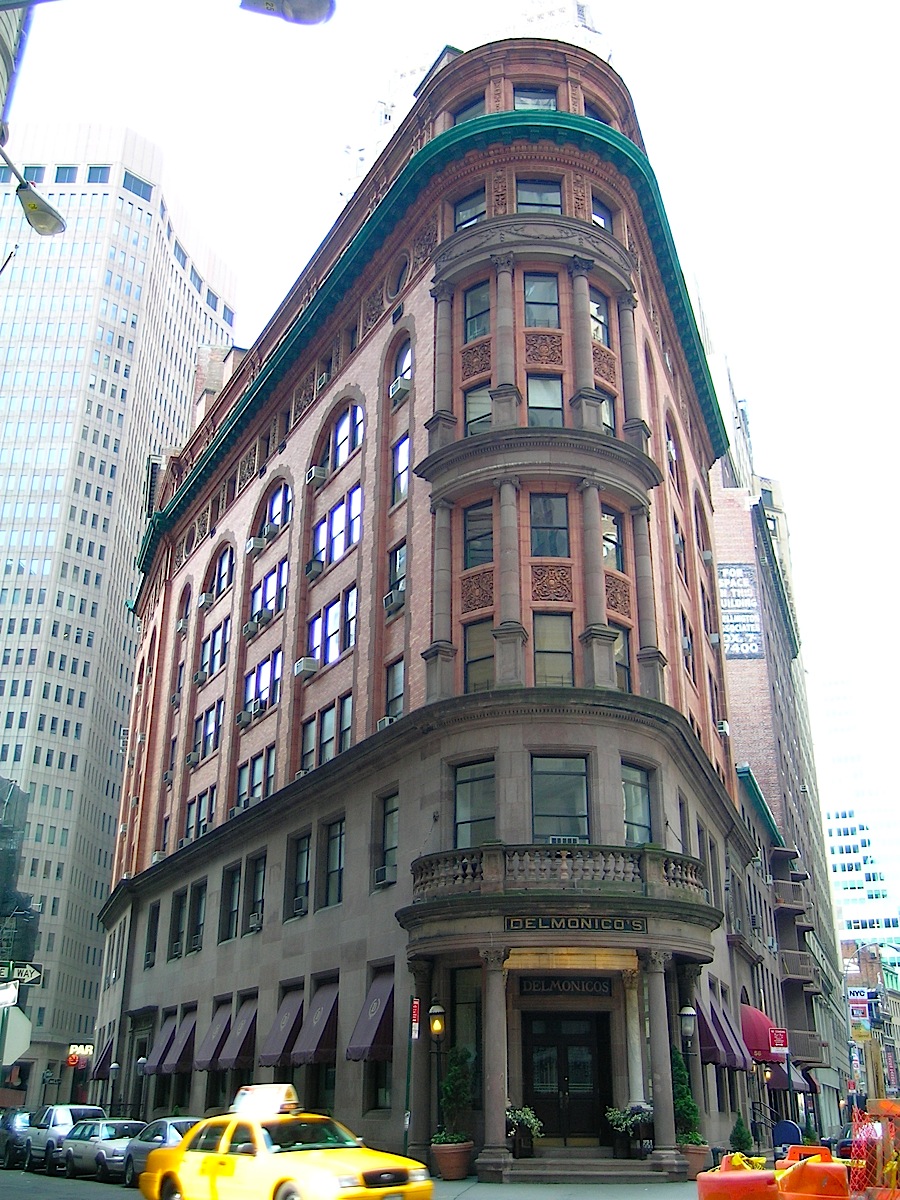 Full-fledged
restaurants
began
to
open
in Paris after the fall of the monarchy (the royal
cooks needed the jobs), but the word “restaurant” doesn’t even appear
in
American print until 1824 when novelist James Fenimore Cooper made note
of the
“renowned Parisian restaurants.” Seven
years later, however, a Swiss sea captain named
Giovanni
Del-Monico brought the concept to New York’s Wall Street area and named
it
after himself, Delmonico’s. Its
success
made
him
and his family
rich, and he opened successive Delmonico’s further and further uptown,
the last
at Madison Square. The second of these (left), with marble columns from
Pompeii as portals. opened on Beaver Street in 1832, is to
this day one of the most popular restaurants in lower Manhattan.
Full-fledged
restaurants
began
to
open
in Paris after the fall of the monarchy (the royal
cooks needed the jobs), but the word “restaurant” doesn’t even appear
in
American print until 1824 when novelist James Fenimore Cooper made note
of the
“renowned Parisian restaurants.” Seven
years later, however, a Swiss sea captain named
Giovanni
Del-Monico brought the concept to New York’s Wall Street area and named
it
after himself, Delmonico’s. Its
success
made
him
and his family
rich, and he opened successive Delmonico’s further and further uptown,
the last
at Madison Square. The second of these (left), with marble columns from
Pompeii as portals. opened on Beaver Street in 1832, is to
this day one of the most popular restaurants in lower Manhattan.
By then
the restaurant had become synonymous with fine dining, and just about
every
important personage in New York and famous visitor to the city,
including
Charles Dickens and William Makepeace Thackeray, dined at “Del’s,” as
its
competitors, like Rector’s and Louis Sherry’s, became equally notable
for the
grandeur and scale of their décor and cuisine.
Other restaurants took
their lead from the New York model, and in 1840 Marseilles-born Antoine
Alciatore opened Antoine’s on New Orleans'
Rue St. Louis in 1840, becoming so much a fixture of the city’s social
life—surviving the Civil War, Prohibition, and Hurricane Katrina—that
local
food writer Gene Bourg contends, “New Orleans without Antoine’s would
be like
Giza without the Great Pyramid.” It was at
Antoine’s that dishes like oysters Rockefeller
were created,
and generations of New Orleanians claimed not only their favorite
dining rooms
but the same waiters over decades.
As American
expanded westward so did the restaurant concept, most often in grand
new hotels
like the Palmer House in Chicago, the Sinton
in Cincinnati, The Planters
in St. Louis, and the Brown Palace in Denver, which
opened in
1892. Still the best hotel in the city, The Brown Palace
has maintained the glorious Gilded Age
décor of its Palace Arms restaurant,
a richly paneled, sumptuous place whose wine cellar is a ward
winning. Every U.S.
president except Coolidge has visited
The Brown Palace.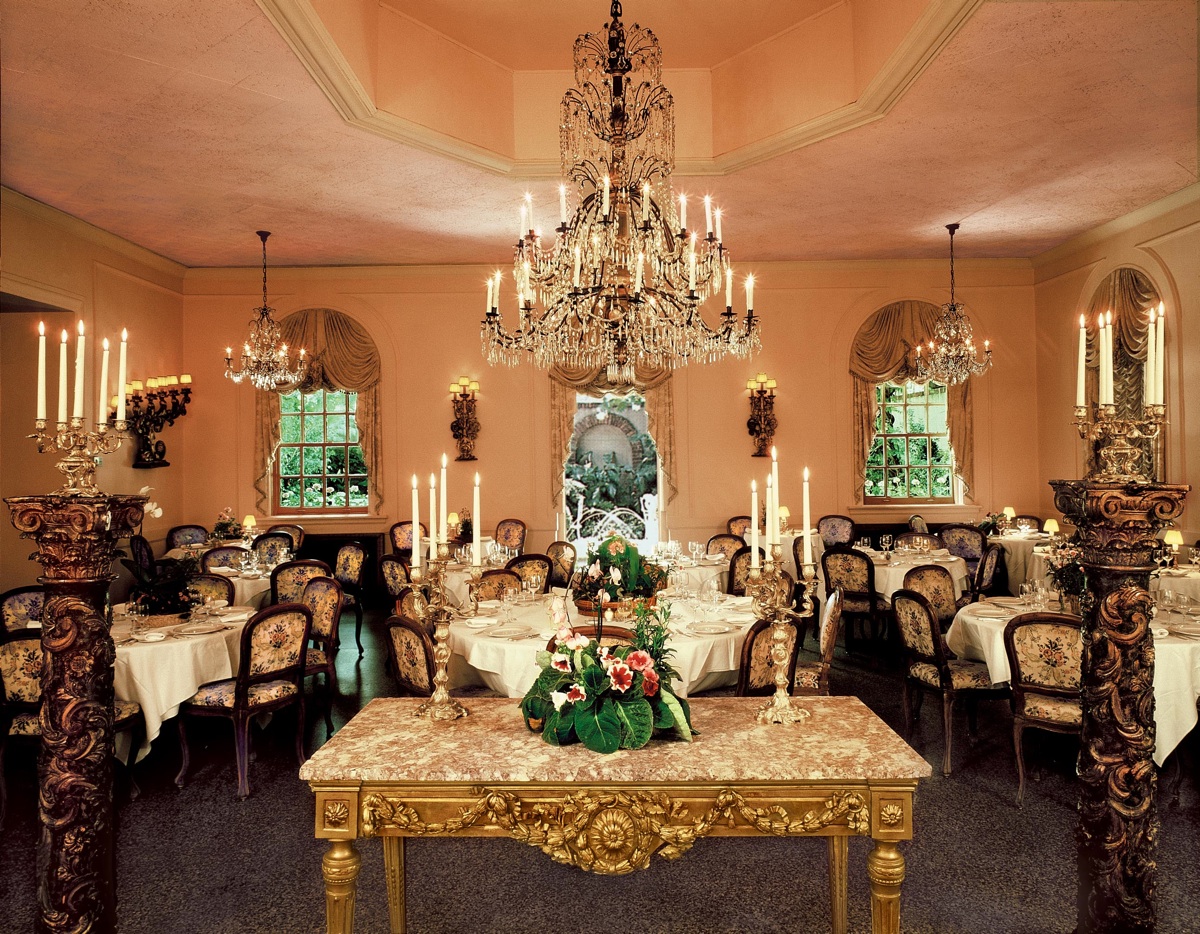
Ethnic restaurants—German
beer halls,
Jewish delis, Italian pizzerias, Mexican chili parlors—proliferated at
the end
of the 19th century, including
many that are still going strong, like Barbetta (1906,
right),
Gargiulo’s (1907), Katz’s
Delicatessen (1888), and Heidelberg
(1936), all in New York; Locke-Öber in
Boston; and El Cholo, which debuted in Los Angeles
in 1923 as one of the first Mexican eateries
to
attract
a Hollywood celebrity crowd. The L.A.
Times has
said, “the El Cholo
restaurants have pretty much defined Mexican restaurant food in the
Southland, and,
by extension, most of the rest of the country.” The original,
on South Western Avenue, has pretty much kept most of
the décor and all of the leafy garden ambiance of those days,
and finely honed
the hospitality for which it has long been famous. You may still find
stars
like Jack
Nicholson, Warren Beatty, and Tom Hanks dropping by for the
margaritas and enchiladas.
Prohibition crippled fine
dining in America throughout the
1920s, when
most of the grand dining halls like Louis Sherry’s and Rector’s went
out of
business for lack of a drinking clientele. In
their
stead
came
the speakeasies, most of them seedy
places serving dreadful food and bad booze. One
exception
was
the
notorious `21’ Club, which catered to New
York society, show biz, and politicians—Mayor “Beau”
James Walker entertained showgirls in the private wine cellar. The liquor was the best money could
smuggle in and the food, while outrageously expensive, among the finest
in New
York. Today `21’ is thriving at
its original location on West 52nd Street, its colorful
jockey
statues still stand on the stairs out front, its Remington paintings
and
sculptures are still arrayed, and its great bar room still hung with
corporate
toys. Scenes from “All About Eve,” “Sweet Smell of Success,” and “Wall
Street”
were filmed here.
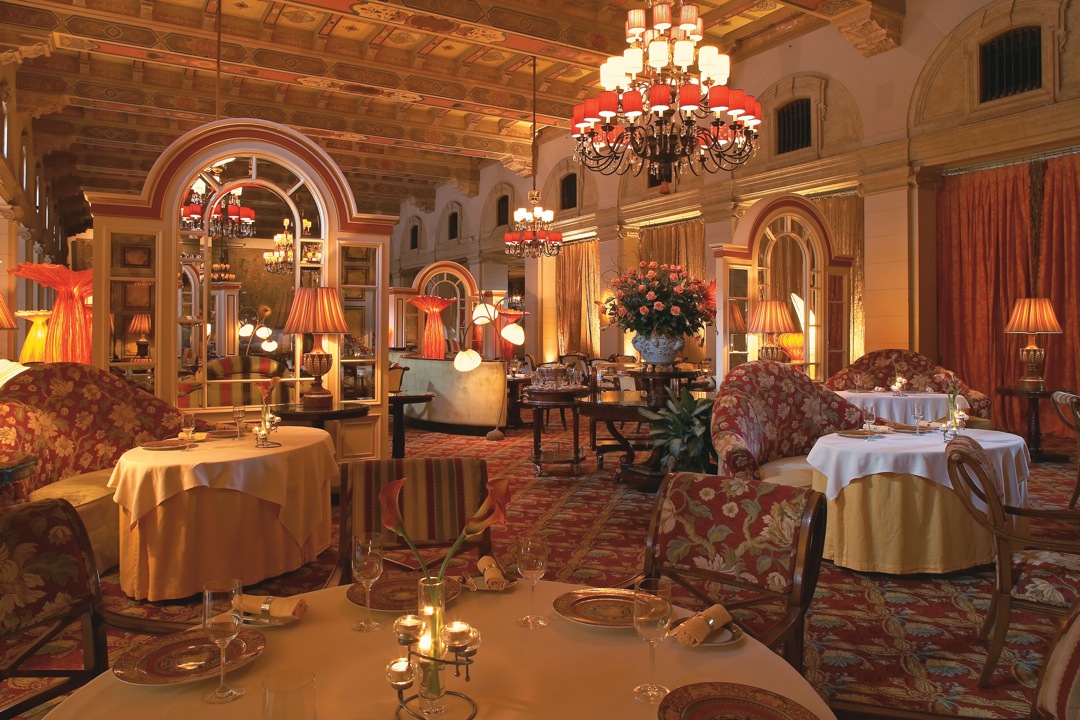 Of course, many of the grandest restaurants
are in historic American resorts, which once catered only to the very
wealthy
but which now have large family clientele, and numerous restaurants for
every
taste. The Breakers, which opened in 1896, in Palm Beach is as
spectacular as any resort in the world, with its magnificent verandah
and long
colonnaded hallways, and its superbly ornate award-winning L’Éscalier
dining
room (left), which has one of
the greatest wine cellars anywhere.
Of course, many of the grandest restaurants
are in historic American resorts, which once catered only to the very
wealthy
but which now have large family clientele, and numerous restaurants for
every
taste. The Breakers, which opened in 1896, in Palm Beach is as
spectacular as any resort in the world, with its magnificent verandah
and long
colonnaded hallways, and its superbly ornate award-winning L’Éscalier
dining
room (left), which has one of
the greatest wine cellars anywhere.
Much
smaller—just 23 rooms--is the Maison de Ville, opened in New
Orleans’
French Quarter in 1905. Tennessee
Williams wrote “Streetcar Named Desire” here, and James Audubon lived
in one of
the seven Audubon Cottages nearby. Its Bistro at Maison de Ville
has a
reputation for easy-going French fare with a Louisiana
lagniappe.
Few resorts can match
the magnificence and period style of the Grand Hotel on
Mackanac Island,
Michigan, opened in1887, with its 66-foot veranda, its suites named
after
First Ladies, its pristinely maintained village, and its fabulous main
dining
room where breakfast, lunch, and dinner are served, and its more rustic, Carleton Varney-decorated Woods
restaurant (below), with
beamed ceilings and stag’s horns like a Bavarian hunting
lodge, and a menu of German specialties like Wiener
Schnitzel,  pferresteak,
and
tafelspitz.
pferresteak,
and
tafelspitz.
Great food can be
found in the most out-of-the-way places, the smallest hole-in-the-wall,
and the
most spectacular new Vegas casino hotel. But
when you add a large dose of American history to the dining
experience, you will have a sense of what it was like when sheer wonder
was
part of the pleasure of dining out. Here are some of my favorites.
Durgin-Park
Café,
Boston—Opened in 1827 in Faneuil Hall Market, Durgin Park looks pretty
much the way it did when workmen and fishermen piled in here for hearty
New
England dinners at communal tables. The
chowder, the baked scrod, and the Indian pudding are
as good as
ever, and the waitresses put on a good act of seeming surly.
Delmonico’s, New
York—The
first true sit-down, white tablecloth, waiter-staffed eating place in
America,
Delmonico’s set the bar for fine dining in America.
Its second incarnation, on Beaver Street, as of 1832 is
still the place the Stock Market guys go to ease their pain at the bar
and eat
great steaks and chops over dinner.
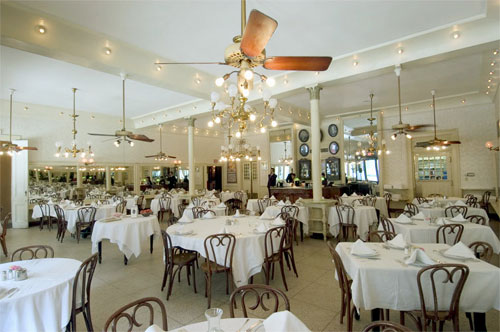 Antoine’s, New
Orleans—Since
1840 Antoine’s has been a rite of passage for generations of New
Orleanians who
have their favorite room and favorite waiters. The rest of us can bask
in the
beauty of the front room (left)
and
feast
on
signature dishes like oysters Rockefeller
and flamed baked Alaska.
Antoine’s, New
Orleans—Since
1840 Antoine’s has been a rite of passage for generations of New
Orleanians who
have their favorite room and favorite waiters. The rest of us can bask
in the
beauty of the front room (left)
and
feast
on
signature dishes like oysters Rockefeller
and flamed baked Alaska.
The Palace
Arms,
Denver—Festooned like a Gilded Age hall within the Brown Palace Hotel
(1892)--the sumptuous Palace Arms is as perfect for a blow-out
celebratory
dinner as for a quietly romantic one. Don’t miss the Colorado bison
“Rossini”
with foie gras, truffles, and Swiss chard.
El Cholo, Los
Angeles—A humble
opening in 1923 led to El Cholo becoming one of the best Mexican
restaurants in
California, a beautiful place with leafy patio, killer Margaritas, and
a celeb
guest list that includes Jack Nicholson, Warren Beatty, and Tom Hanks.
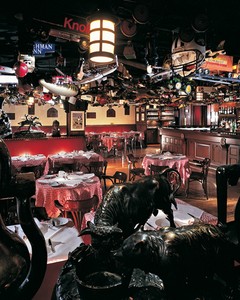
`21’ Club, New
York--As infamous
during Prohibition as it became famous after its repeal, `21’ has never
been a
better place to dine and nowhere will you find a truer sense of New
York
sophistication and swagger in equal parts. The
`21’
burger
is
as good as they say, the main dining room (left) is still hung with corporate
toys, the winelist
stellar, the wine cellar worth a look-see.
Grand Hotel, Mackanac
Island, Michigan—Since 1887, the Grand Hotel has been the ultimate
in American
hospitality, not least in its two fine restaurants, the main Dining
Room, whose
huge size is part of the fun of seeing people, and Woods, a reverie of
a
Bavarian hunting lodge. The best items are German-inspired, like crisp Wiener Schnitzel and boiled beef called tafelspitz.
`````````````````````````````````````````````````````````````````````
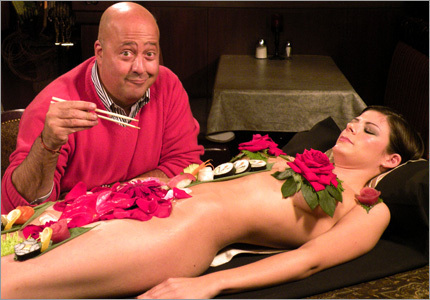 AW,
SHOOT, AND ANDREW ZIMMERN
ALREADY HAD PLANNED TO
EAT IT ON
HIS "BIZARRE FOODS" TV SHOW!
AW,
SHOOT, AND ANDREW ZIMMERN
ALREADY HAD PLANNED TO
EAT IT ON
HIS "BIZARRE FOODS" TV SHOW!
The
Australian edition of The Pasta
Bible printed a recipe for tagliatelle with sardines and
prosciutto
required "salt and freshly ground black people" as ingredients.
Penguin
Australia blamed the issue on a spell-checking program. All 7,000
copies of
the book at the warehouse were destroyed at a cost of $
20,000. Penguin also said it would willingly replace a copy of Pasta Bible owned by anyone who
"feels
uncomfortable" about having a copy of the book in their possession.
NEW PRODUCTS DEPARTMENT: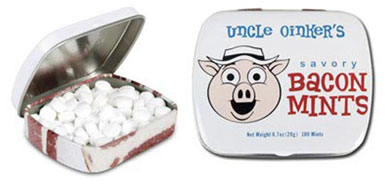
MAKES YOUR BREATH SMELL JUST LIKE PORKY PIG'S TOO!
`````````````````````````
QUICK
BYTES
OWING TO THE OVERWHELMING NUMBER OF MOTHER'S DAY ANNOUNCEMENTS AND DINNERS, I AM UNABLE TO INCLUDE ANY IN QUICK BYTES.
* On April
30-May 2 in
Hamburg, NJ, the Crystal Springs Resorts hosts the
2nd Annual New Jersey
Food &
Wine Festival. incl. a
grand tasting,
charity dinner and wine auction, exclusive wine cellar dinners with
vertical
wine pairings, seminars with winemakers and chefs, and a celebrity chef
golf
tournament. Proceeds to Share Our Strength. Tix
$30-$400. Overnight
packages available on the website at www.njfoodandwinefestival.com. Call
888-299-0585.
*
On May 1 in NYC, Wildwood BBQ will
celebrate the Kentucky
Derby from 11am-7pm. Visit brguestrestaurant.com or call
212-260-5444.
* From May 1
– Aug. 1, the Portland On Tap package at the Hotel
Monaco Portland in Portland, OR,
offers a taste of the city’s burgeoning microbrewery scene.
Package incl. 22 oz bottle of Oregon beer, Oregon Brewers Guild pint
glasses, Oregon beer
flights at Red Star Tavern & Roast House and a pocket-sized beer
tasting
notebook. Rates start at $169. Visit www.monaco-portland.com
or call 503-222-0001.
* On
May 8 the Southern Food and
Beverage Museum in New
Orleans, will be hosting a panel discussion called
"Recipes of Resilience: Building Sustainable Food Systems in
Post-Katrina New
Orleans." led by Claire Menck and will incl. speakers
representing Mary Queen Viet Nam Community Development Center, the
Latino
Farmer’s Cooperative, and Our School at Blair Grocery in the Lower 9th
Ward.
Free for members, $10 for non-members. 504-569-0405 or info@southernfood.org
*
On May 15 in Lodi, CA, Lodi Wine Country will host the 6th
Annual ZinFest Wine Festival – Wine,
Food & Fun at Lodi
Lake, with 50+ wineries. Live music.
Browse a diverse selection of
merchandise from regional vendors and take home a bottle of ZinFest
Commemorative Old Vine Zinfandel, custom blended by Michael-David
Family of
Wines. $45 pp in advance, $55 pp at the gate. Call the Lodi Wine &
Visitor
Center at 209-365-0621.
*On May 15,
in Chicago, IL, Ben
Pao offers a Tofu Cooking Class with guest
Jenny Yang of Phoenix Bean along with Ben Pao's executive chef
Jim Hoveke. The class includes tofu samples, a
$10 Ben Pao gift certificate, and lunch consisting of a variety of Ben
Pao's
tofu-inspired menu items. $35 pp. Call 312-222-1888 or visit
benpao.com for more information.
* On May 15 in San Jose, CA, Left Bank Brasserie Santana Row will host a Sierra Nevada Brewing Co. Beer Brunch with a 4-course menu by Chef David Bastide. $40 pp. Call 408-984-3500 or visit www.LeftBank.com.
* On May 16, in St. Helena, CA, The Brother Timothy Memorial Dinner Celebration, to benefit the Lasallian Education Fund, will be held at the Culinary Institute of America at Greystone. The leaders, founders, and owners of 30 wineries will host tables Dominic Orsini, head chef at Silver Oak Cellars, will preside over the meal. $500 pp, a table of 8 co-hosted by a vintner is $3,000. Call 415-332-3471.
* On
May 17, Share Our Strength’s
premier culinary event, Taste of the Nation® NYC
will be held at the Grand Hyatt NYC,
featuring
more
than
50
of
NYC's
finest
restaurants.
$275
pp;
$375
pp
VIP. Visit www.newyorktaste.org or call 877-268-2783.
*
On
May
17,
Thalassa in NYC, will hold a 4-course Wine
Dinner hosted
by Dennis Cakebread, co-owner of Cakebread Cellars in Napa
Valley. $125
pp. Call 212-941-7661. . . . On June 7, Thalassa will host a
Greek Summer Cooking Class
celebrating the summer cocktail party. Executive Chef Ralpheal
Abrahante
will demon how to cook Greek mini hors d'oeuvres in the restaurant's
open
kitchen. $75 pp. Call 212-941-7661. . . . On June 14, Thalassa
iill host a 2nd Summer Cooking Class
celebrating the summer cocktail party. Chef Abrahante
will demonstrate how to cook Greek mini desserts in the restaurant's
open
kitchen. $75 pp. Call 212-941-7661.
On May 17, Share
Our Strength’s premier culinary event, Taste
of
the
Nation®
NYC
will be held at
the Grand Hyatt New York, with a VIP reception starting at 7pm. More
than 50 restaurants will feature signature dishes,. $275 for
General Admission and $375 for VIP. Virtual Table packages are also
available.
Visit www.newyorktaste.org
<http://www.newyorktaste.org>
or calling 1-877-26 TASTE.
* On
May 18, in Newton, MA,
Chef Michael Leviton of Lumiere restaurant
hosts
an
exciting
wine
dinner
with
Robert
and
Maria
Helm
Sinskey
of
Robert
Sinskey
Vineyards
with
a
menu
featuring
Tub-Trawled
Stonington Maine Halibut,
Vermont
Quail Breast and Raincrow Ranch Grass-Fed Beef Rib Steak. $150
pp. Call 617-244-9199 or visit
www.lumiererestaurant.com.
*On
May
18
in
New York, NY, Children of
Bellevue Hosts Tom Colicchio’s 14th Annual
“Toast
to the Children” Food and Wine Tasting Fundraiser at
Gotham Hall, incl. Blue Smoke, Boqueria,
Colicchio & Sons, Craft, Double Crown, Graffiti, Hearth, L'Artusi, Pearl
Oyster Bar,
Peasant, Perilla, Porchetta, Public, and Tabla, hosted by
WNBC's Cat Greenleaf and Uma Thurman. Tickets start at $250. Visit www.childrenofbellevue.org
or call 212-562-4130.
* On May 20 in San Francisco, CA, McCormick & Kuleto’s Seafood Restaurant
will host a Hope & Grace Winemaker Dinner with a five-course prix
fixe menu
prepared by Chef Liz Ozanich. $80.00 pp. Call 415-929-1730 or visit
www.mccormickandkuletos.com.
Everett Potter's Travel Report:

~~~~~~~~~~~~~~~~~~~~~~~~~~~~~~~~~~~~~~~~~~~~~~~~~~~~~~~~~~~~~~~~~~~~~~~~~~
Eating Las Vegas is the new on-line site for Virtual Gourmet contributor John A. Curtas., who since 1995 has been commenting on the Las Vegas food scene and reviewing restaurants for Nevada Public Radio. He is also the restaurant critic for KLAS TV, Channel 8 in Las Vegas, and his past reviews can be accessed at KNPR.org. Click on the logo below to go directly to his site.
~~~~~~~~~~~~~~~~~~~~~~~~~~~~~~~~~~~~~~~~~~~~~~~~~~~~~~~~~~~~~~~~~~~~~~~~~~~
Tennis Resorts Online: A Critical Guide to the World's Best Tennis Resorts and Tennis Camps, published by ROGER COX, who has spent more than two decades writing about tennis travel, including a 17-year stretch for Tennis magazine. He has also written for Arthur Frommer's Budget Travel, New York Magazine, Travel & Leisure, Esquire, Money, USTA Magazine, Men's Journal, and The Robb Report. He has authored two books-The World's Best Tennis Vacations (Stephen Greene Press/Viking Penguin, 1990) and The Best Places to Stay in the Rockies (Houghton Mifflin, 1992 & 1994), and the Melbourne (Australia) chapter to the Wall Street Journal Business Guide to Cities of the Pacific Rim (Fodor's Travel Guides, 1991). THIS WEEK:

Family Travel
Forum: The
Family
Travel
Forum
(FTF),
whose
motto
is
"Have
Kids,
Still
Travel!",
is
dedicated
to
the
ideals,
promotion
and
support
of
travel
with
children.
Founded by business professionals John Manton and Kyle
McCarthy with first class travel industry credentials and global family
travel experience, the independent, family-supported FTF will provide
its members with honest, unbiased information, informed advice and
practical tips; all designed to make traveling a rewarding, healthy,
safe, better value and hassle-free experience for adults and children
who journey together. Membership in FTF will lead you to new worlds of
adventure, fun and learning. Join the movement.
All You Need to Know Before You Go
nickonwine: An engaging, interactive wine column by Nick Passmore, Artisanal Editor, Four Seasons Magazine; Wine Columnist, BusinessWeek.com; nick@nickonwine.com; www.nickonwine.com.

MARIANI'S VIRTUAL GOURMET NEWSLETTER is published weekly. Editor/Publisher: John Mariani.
Contributing Writers: Robert Mariani,
John A. Curtas, Edward Brivio, Mort
Hochstein, Suzanne Wright, and Brian Freedman. Contributing
Photographers: Galina Stepanoff-Dargery, Bobby Pirillo. Technical
Advisor:
Gerry McLoughlin.
Any of John Mariani's books below
may be ordered from amazon.com by clicking on the cover image.
 My
newest book, written with my brother Robert Mariani, is a memoir of our
years growing up in the My
newest book, written with my brother Robert Mariani, is a memoir of our
years growing up in the For those of you who don't think of the Robert and I think you'll enjoy this very personal look at our --John Mariani |
 |
 |
 |
 |
 |
 |
© copyright John Mariani 2010
